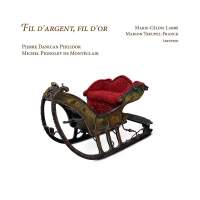Texte paru dans: / Appeared in: |
|
|
Outil de traduction ~ (Très approximatif) |
|
|
Reviewer: Barry
Brenesal In the early years of the 18th century, France possessed a number of what we might term composers who were into vertical integration. Some performed, composed, and gave lessons on one or two specific instruments. A few went so far as to cover the production costs to publish the works they themselves wrote, and for the instruments they had crafted to their own specification, then personally sold and taught others to play. It was a thriving market, in part because the middle and upper classes of the day believed that several artistic skills were essential to well-bred members of society. The recorder was played by everybody; so these same composers began selling locally built transverse flutes as elite instruments, suitable for their aristocratic clientele. Its marketing could be quite sophisticated at times. One aristocrat wrote a friend that Jacques Hotteterre le Romain greeted him kindly in his studio, showed him some scores, and played a few pieces to indicate just how easy it was to gain moderate proficiency with his personal, hands-on lessons. Hotteterre then removed from an elegant case an ivory flute, which he said might interest a gentleman of his visitor’s distinction. Subtlety wasn’t always on display, however, and at the other end of the self-advertising scale was Michel de la Barre’s deceptively ingenuous notice for his second book of pieces for flute with continuo: “There are two or three notes that I believe no one knows [how to produce], and I would not know how to tell him in writing to perform these notes; but if those who would like to learn would take the trouble to pass by my home … it would give me great pleasure to show them how, with no obligation to them.” Pierre Danican Philidor (1681–1731) was, like Hotteterre le Romain, a member of a far-reaching musical dynasty. Unlike Hotteterre, he isn’t considered one of the more important members by musical historians. Their perspective is understandable, yet this particular Philidor was an oboist and flutist in the Musique de la Grande Écurie, and a gambist in the Petits Violons de la Chamber, both highly prestigious positions of service to Louis XV. His knowledge of his instruments was considerable, as was his comprehension of les goûts-reunis, the merging of then-current mainstream secular French and Italian musical styles. Like Hotteterre and de la Barre, he was among the first to publish several books of relatively easy works for two transverse flutes, suitable for noble amateurs who sought to learn from music-making rather than exercises alone. This recording gives us all six of the suites for two flutes without continuo that Philidor published in 1718, during the early years of that instrument’s climb to fame and fortune. All are in four movements, sonate da chiesa in tempo—perhaps a nod to Corelli, but with nothing sonata-like in their structure. Most are dances; a few are listed as fugues, but each abandons the attempt for generalized counterpoint and brief imitation after a first statement. Most movements range from two to three minutes. (One opening movement, simply marked affectuesement, is an exception, approaching five minutes with an ABA structure, while the shortest, marked gayment, is under a minute in length.) They are without exception tuneful works of light difficulty, though a few display some harmonic sophistication. Interspersed throughout the album are ten short works by Michel Pignolet de Montéclair, transcriptions he published around 1695 of popular tunes of the day. These brunettes (so named from a recurring line in a verse of the song La beau berger Tircis) are usually a bit more folk-like than Philidor’s suites, with melodic lines that reveal their origins as vocal music. There isn’t any strong contrast with Philidor’s music, though, so their inclusion may instead by guided by a need for transitions of mood and key. The performances are fine ones. Marie-Céline Labbé and Marion Treupel-Franck both possess agility, good production, and strong breath support. They work together in a way that speaks of many hours spent learning how to play as a team. Their instruments are a pair of modern Baroque flutes crafted by Rudolf Tutz after the manner of Brussels-based Jean Hyacinthe Rottenburgh (1672–1765), whose wind instruments were so popular for their tone during his lifetime that many forgeries were made and sold. (The forgeries didn’t make a bad instrument good, but they did sell a good instrument more easily; and some 18th-century instrument forgeries are still regarded highly today.) The engineering is excellent, the side length, exceptional. This is definitely a niche recording, apt to appeal only to wind soloists and fanciers of the French Baroque. If you fall into either category, however, you’ll find much to enjoy here. | |
|
|
|
|
Cliquez l'un ou l'autre
bouton pour découvrir bien d'autres critiques de CD |
|




